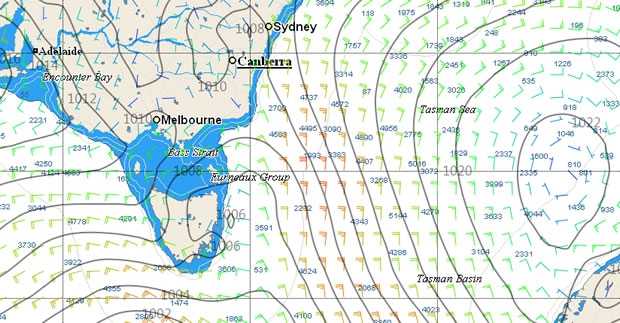Weather not looking record breaking
Chart above courtesy of Expedition/Tasman Bay Navigation Systems and PredictWind
Early weather forecasts for the Rolex Sydney Hobart delivered to a panel of skippers this morning have ruled out a record run for the super maxis.
There will no straight line dash, foot planted on the throttle from the 1pm start on Sydney Harbour to the Derwent River for the crews of Wild Oats XI, Investec Loyal and their rivals. Canny navigating and getting the balance right between boat speed and boat preservation will be key.
This will be equally true for the rest of the fleet battling for the Tattersall’s Cup as they shape up for a classic tactical Rolex Sydney Hobart where smarts, not brute strength will carry the day.
The good news is that Bureau of Meteorology regional director Rob Webb isn’t predicting huge winds this year, but nor is he forecasting a pleasant or sunny cruise.
“We think the race will start in a 10 to 15 knot north easterly breeze, so there will be a tailwind over the first 6 to 12 hours,” Webb says, “but a southerly will move in during that first evening. It probably won’t have that much push to it at first, maybe 15 to 20 knots, but overnight it will build to 20, perhaps 30 knots. Over the next day or two it will be on the nose, with south and south west winds affecting the fleet.”
The timing of that first southerly shift will be crucial, especially if the big boats are going to contest the handicap race. The various forecasting models are undecided at this stage.
Some are saying the shift will come about 6 hours into the race, while Adrienne Cahalan, co-navigator of Wild Oats XI, hopes the American model, which pushes the change back to 12 hours, will turn out to be right: “If we can just get 6 or 8 hours of running down the coast that makes a big difference to us in terms of overall [handicap] possibilities,” she says.
The longer the northerly lasts the bigger the distance the maxis can put between themselves and the 50 and 60 footers that most threaten them on handicap, both in terms of shear distance, and in terms of racing in a different and perhaps advantageous weather system compared to the boats further back up the coast.
“If we get 12 hours of running we’re close to Gabo Island that makes a massive difference. But there is too much southerly in this forecast for the big boats [on handicap],” Cahalan added. She prefers the prospects of the 50 to 60 foot grand prix yachts this year. “For the middle boats, the TP52s, this is a classic Hobart forecast.”
Adding to the mix is Tropical Cyclone Fina, currently off the Queensland coast. Rob Webb doesn’t expect Fina will directly affect the race, but it will produce a strong northerly swell.
Over time the southerly winds will build up short sharp wind waves running in a different direction to the swell, and this will make conditions very uncomfortable as waves cross in different directions over Bass Strait’s shallow rock shelf. Think of a washing machine on a three to four day cycle. The game starts to shift from maximising boat speed to preserving equipment and the boat.
“Once the boat starts to get beaten about by a seaway you have to reassess how you sail the boat,” says Cahalan, which is usually code for pulling back on the throttle. When the wind does shift to the south, it will not then settle into a steady, straightforward direction. It is expected that it will swing around a lot between the south and the south west.
The race will evolve into a giant chess game. Picking the shifts and being on the right part of the course to take full advantage of them will be the job of the navigators and tacticians.
Mike Broughton, navigator on Chris Bull's Cookson 50 Jazz, says tactics will be especially crucial in the intensely competitive middle of the fleet, where the overall winner is likely to come from: “The big wind shadow of the Tasmanian coast will be crucial. We’ll probably spend more time in south westerlies than south easterlies as we approach Tasman Island, and how we deal with the wind bending around the corner will be quite hard. Do you go close to the shore to get out of the sea state?”
Jazz finished second overall last year and owner, Chris Bull, doesn’t want to be a bridesmaid again, says Broughton. "I have an owner who has the Hobart disease bad. He’s come overall twice, and has no interest in coming second again. For him, second overall is a failure.”
Stan Honey, who will navigate Anthony Bell’s 100 footer, Investec Loyal, the 628 nautical miles to Hobart, sums up the forecast succinctly: “The tricky part of this race will be being in position for the wind shifts. The cross sea will be about not breaking the boat, and backing off as appropriate.”
A least four crew from each of the 88 yachts entered in the Cruising Yacht Club of Australia’s blue ribbon event must attend Saturday’s race briefings (9am and 11am) where the Bureau of Meteorology will deliver its official race forecast.
At 8.30am on race day, 26 December, skippers and navigators will attend a final weather briefing before heading to the start line for the 67th edition of the southern hemisphere’s most famous ocean race.












Latest Comments
Add a comment - Members log in